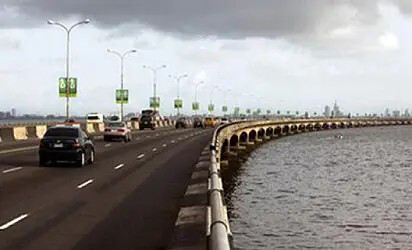
Nigerians will informally begin using the reconstructed section of the third mainland bridge in seven days, according to a statement made by the Federal Government (FG) through the Ministry of Works.
This was revealed on Thursday during an inspection exercise of the third mainland bridge conducted by the Senate Committee on Works and the Minister of Works, Senator Dave Umahi.
In an effort to stop illicit sand mining in the region, Umahi also revealed that the Federal Government intends to erect closed-circuit television (CCTV) on top of and beneath the third mainland bridge.
“We will open the bridge when the lane marking is finished, but Mr. President will formally commission it when he flags off the coastal road,” he stated. Thus, we’ll mix it.
"The lane marking is the most crucial component."We formally open the road as soon as the lane markings are completed.
Nigerians will be able to use this road in seven days.
We also found that there is a need for CCTV under the bridge as well as on top of it. Since we don’t want to use diesel generators to power the CCTV, we will purchase a solar generator and install it throughout the 11.8 kilometers. Additionally, we will install CCTV under the deck to monitor illegal sand mining, which has caused us to run into issues with the integrity of the skin friction-driven pipes. We will investigate this issue when we visit the area tomorrow.
“The bridge before now and over the years and administrations was being maintained by overlaying asphalt upon asphalt on top of the concrete decks and the dead loads designed for the concrete deck is just two inches of asphalt,” he said in explaining the reason behind the project’s expanded scope.
As a result, the bridge experienced dead weight due to the 10 to 30 centimeters of asphalt overlay that we have had throughout the years.
Let me state that there has been some depletion in certain areas of this bridge.
However, the dead weight has been eliminated. Upon our arrival, the President inspected the bridge and gave the go-ahead for its prompt reconstruction.
We were given a contract to mill a mere two inches to begin with.
We believed that two inches of asphalt had failed, so we acquired the bridge in the following manner: two inches of asphalt were milled, eight lanes measuring 11.8 km were replaced, 90% of the expansion joints were changed, the parapet capes were painted, and all of the electric poles were replaced with solar poles, as per the original plan.
However, the extra scope grew after that. We are installing a single 30-meter-tall pole at the median with two solar panels on it. Additionally, we are installing an additional electric pole at the side of the bridge.
Thus, this introduction is entirely new. Thus, our starting point on the first day was in the center of the median. The ramps were not factored, as we later found out, and as a result, we put in solar lighting for the ramps, which raised the project’s cost.
We also found that we needed to mill between 10 and 30 centimeters. After looking at it in the text, we saw that even milling two inches would put the bridge at risk, so we decided to mill everything, which added to the expense of the project.